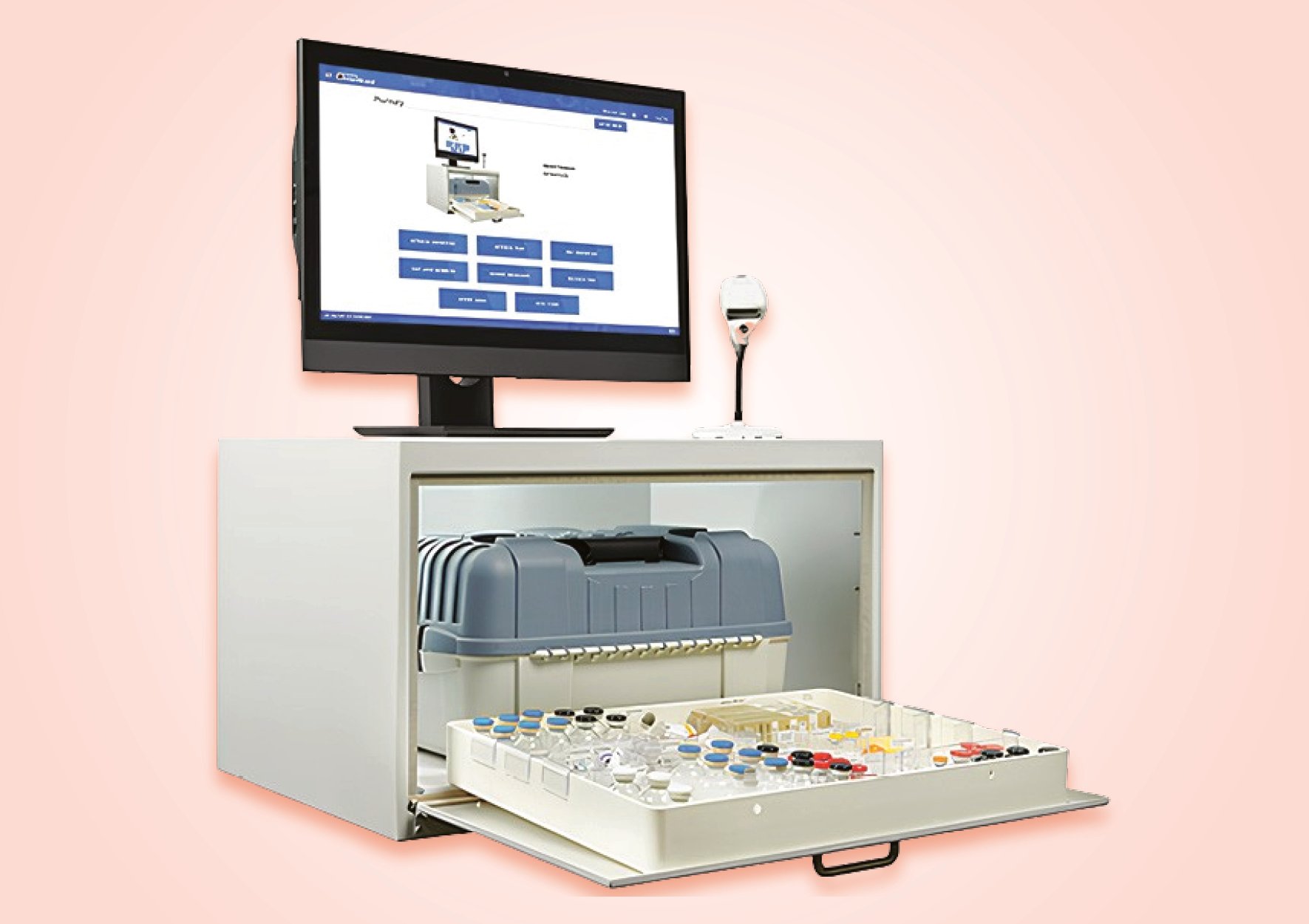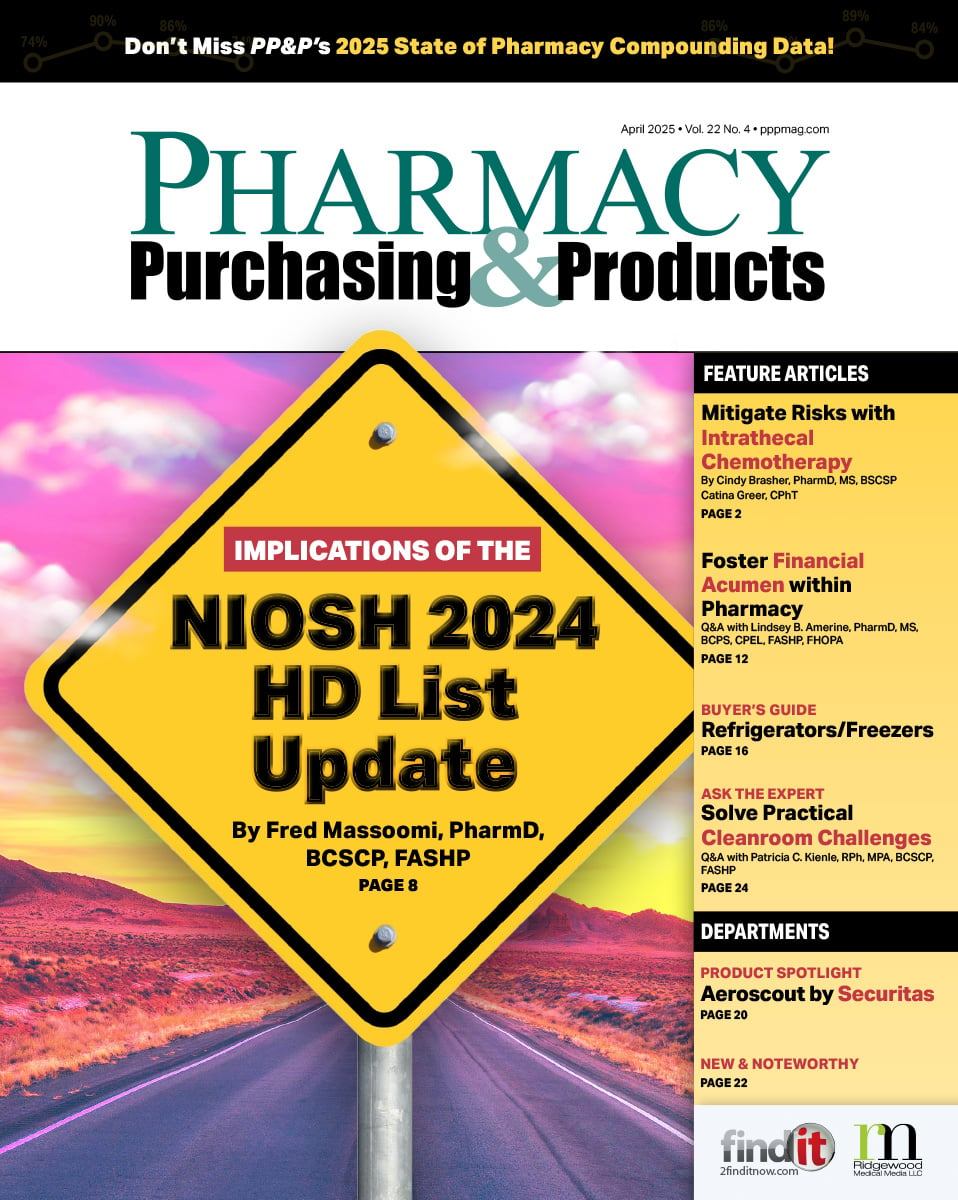- Show Menu
- Contact Us
- FAQs
- Reader Service
- Survey Data
- Survey Winners
- Testimonials
- Upcoming Events
- Webinars
- White Papers
Safe PN Compounding and Administration
Despite parenteral nutrition (PN) being designated a high-alert medication by The Institute for Safe Medication Practices (ISMP),1 a recent survey reported that only slightly more than half of organizations have precautions in place to prevent errors and patient harm associated with PN use.2 The American Society for Parenteral and Enteral Nutrition’s (ASPEN) Parenteral Nutrition Safety Consensus Recommendations address safety concerns throughout the PN process, including prescribing, order review and verification, compounding, and administration of PN.3 Compliance with these recommendations is critical to prevent PN errors and avert the potential for patient harm throughout the PN process; thus, organizations must ensure they fully understand and implement the ASPEN recommendations.
This is the second part of a two-part article series: Part 1 (Safe Parenteral Nutrition Prescribing and Order Review, June 2017 issue of PP&P) addressed potential errors that may occur during PN prescribing, order review, and verification; Part 2 addresses the prevention of errors in the compounding and administration phases of the PN process.
Prevent PN Compounding Errors
PN preparations can be compounded as customized or standardized admixtures, with customized PN formulations individualized to each patient, while standardized PN formulations vary according to each institution’s specifications. In addition, commercially manufactured, multi-chamber PN products are available. These products may require the addition of multivitamins, trace elements, and other additives, under sterile compounding conditions, for delivery of a complete, intravenous nutritional regimen.
Compounding errors can result in serious, even fatal, consequences. An ISMP Medication Safety Alert described two deaths associated with PN compounding errors.4 The first involved a 6-week-old infant who died after receiving 60 times more sodium than prescribed. The second death was an infant who received a 1000-fold zinc overdose resulting from an error in entering a PN order into automated compounding device (ACD) software.
These tragedies highlight the need for increased PN education. A survey of first-year pharmacy residents reported limited or no experience in the areas of PN evaluations and IV admixtures (ie, on a scale from 1 to 5 [5=most experience and 1=no experience or minimal experience; median score=2]).5 One of the ASPEN recommendations encourages United States schools of pharmacy to develop curricula that address proper aseptic technique and USP Chapter <797> guidelines related to producing compounded sterile preparations (CSPs).3 In addition, the recommendations provide guidance to reduce compounding errors related to PN (see TABLE 1).
Ensure Safe PN Administration
PN administration errors are more likely to cause harm as they occur at the point of patient contact. Because PN is administered in a variety of settings, from acute care facilities to personal residences, this creates the potential for disparities to exist in technology, equipment, nursing care, and caregiver oversight in the administration of PN.
It is not uncommon for errors to occur during PN administration. A prospective, observational study of PN errors reported that 35% of PN errors occurred during the administration process,6 while a similar audit of almost 20,000 PN days in a tertiary pediatric hospital revealed that administration-related errors accounted for 30% of PN errors.7 A recent case report described a patient who developed severe metabolic and respiratory acidosis secondary to infusion of 1800 mL of PN and 200 mL of lipid injectable emulsion (ILE) in less than 1 hour. The patient required plasma exchange to correct the imbalances.8
The administration section of the ASPEN recommendations provides guidance to enhance the safety of PN administration (see TABLE 2).3
Conclusion
Because PN is a complex medication that is designated high risk by ISMP, P&Ps should be in place to address all phases of the PN process. Standardized procedures that utilize computerized ordering with clinical decision support at the point of prescribing should be the goal of health care organizations involved in the delivery of PN. Given the risks that accompany PN compounding and administration steps, appropriate training and annual assessment of competency in these areas are important mechanisms to ensure the safe delivery of PN. PN should be managed using a multidisciplinary approach based on published guidelines and recommendations from national organizations. Reading and understanding the ASPEN Parenteral Nutrition Safety Consensus Recommendations is critical to ensuring safety throughout the PN process.
References
- Institute for Safe Medication Practices. ISMP’s List of High-Alert Medications in Acute Care Settings (2014). www.ismp.org/tools/highalertmedications.pdf. Accessed June 5, 2017.
- Boullata JI, Guenter P, Mirtallo JM. A parenteral nutrition use survey with gap analysis. JPEN J Parenter Enteral Nutr. 2013;37(2):212-222.
- Ayers P, Adams S, Boullata J, et al. A.S.P.E.N. parenteral nutrition safety consensus recommendations. JPEN J Parenter Enteral Nutr. 2014;38(3):296-333.
- Institute for Safe Medication Practices. ISMP Medication Safety Alert! (April 21, 2011). www.ismp.org/newsletters/acutecare/articles/20110421.asp. Accessed August 25, 2017.
- Garris K, Wellein MG, Wessell A, et al. First-year residency candidates’ experience in various areas of pharmacy practice. Am J Pharm Educ. 2008;72(1):6.
- Sacks GS, Rough S, Kudsk KA. Frequency and severity of harm of medication errors related to the parenteral nutrition process in a large university teaching hospital. Pharmacotherapy. 2009;29(8):966-974.
- Narula P, Hartigan D, Puntis JWL. The frequency and significance of errors related to parenteral nutrition in children. Proc Nutr Soc. 2010;95:A55-A56.
- Lodeserto F, Al-Jaghbeer M, Haung D. Accidental bolus of parenteral nutrition. JPEN J Parenter Enteral Nutr. 2016;40(6):883-885.

Phil Ayers, PharmD, BCNSP, FASHP, is a clinical specialist in nutrition support and chief of clinical pharmacy services in the department of pharmacy at Baptist Health Systems in Jackson, Mississippi. He serves as secretary-treasurer for the board of directors of ASPEN, and is the current president of the Mississippi Pharmacists Association. Phil received his BS in pharmacy and his PharmD from the University of Mississippi.

Jenny Anderson, MS, RD, LD, CNSC, is a registered dietitian at Baptist Health Systems in Jackson. She completed her undergraduate degree in nutrition and dietetics at the University of Southern Mississippi and obtained her Masters Degree from the University of Alabama.

Carman Dixon, PharmD, is a clinical pharmacy specialist at Mississippi Baptist Medical Center in Jackson. He is the lead pharmacist for the Pharmacokinetics Service in addition to serving on the Medication Safety and Pharmacy and Therapeutics Committees. He is a past-president of the Mississippi Society of Health-System Pharmacists and is the current education chairman for the Mississippi Pharmacist Association. Carman received his PharmD from the University of Mississippi.

Andrew Mays, PharmD, CNSC is a clinical pharmacy specialist in nutrition support at the University of Mississippi Medical Center in Jackson. He is a clinical assistant professor at the University of Mississippi School of Pharmacy. Andrew serves as president-elect for the Mississippi Society of Health-System Pharmacists and president of the Mississippi Society for Parenteral and Enteral Nutrition. He received his PharmD from the University of Mississippi.
TABLE 1
ASPEN Recommendations for Reducing PN Compounding Errors
- Ensure compliance with USP Chapter <797> standards
- Put P&Ps in place to address all aspects of PN compounding
- Develop in-depth training programs on CSPs for all staff members supervising or participating in the preparation of CSPs/PNs
- Conduct an annual competency assessment program
- Implement automation and technology
- Establish soft and hard limits for PN ingredients
- Limit access to automated compounding devices to select, qualified individuals
- Only allow pharmacists to override alerts using an independent double-check process
- Review reports detailing frequency of overrides
- Optimize and validate the additive sequence of compounding
- Utilize checklist and sign-off sheets
- Regularly assess the physical environment in which PN compounding takes place
TABLE 2
ASPEN Recommendations for Enhancing the Safety of PN Administration
- Create written P&Ps to standardize nursing practice
- Provide education and competency assessments for nurses, patients, and caregivers
- Establish interdisciplinary quality improvement programs to analyze medication errors associated with PN
- Use an interdisciplinary process to select and evaluate equipment and technology
- Ensure that P&Ps address extravasation of PN
- Develop protocols for safe operation of infusion pumps
- Stipulate that a visual inspection of the PN container and formulation must occur before spiking
- Require verification of PN label against the original prescription
- Insist that administration tubing be traced to the point of origin
- Conduct independent double-check of infusion pump settings
- Ensure that PN is infused through the appropriately sized filter
- Require a review of compatibility and stability by a pharmacist for co-infusion of medications
Like what you've read? Please log in or create a free account to enjoy more of what www.pppmag.com has to offer.








